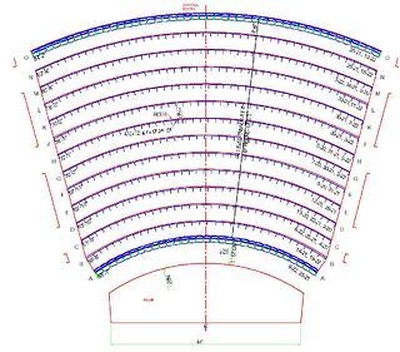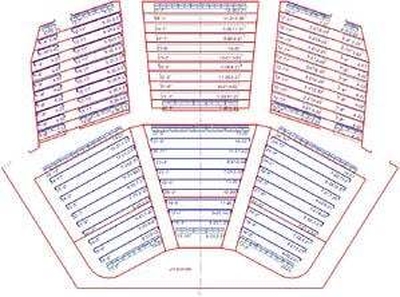5 Things To Know About Seating Configurations In An Auditorium
By Jenna Brown
April 10, 2020

The configuration of the seating in your auditorium is a major factor in capacity, comfort, and the overall experience for your patrons. There’s a lot to consider when it comes to the seating configuration of your auditorium, so we’ve got the basics laid out here to help get you started.
1. Stage Type
Understanding the stage type in the auditorium will help determine a general idea of the layout needed for the space function and patrons comfort. There are several different types of stages, the most popular seen in auditoriums:
Proscenium Stage
- Considered the typical "theatre stage." This stage is most popular is historic venues.
- Generally framed or has an arch that leads to the stage. Also typically includes an orchestra pit.
- Audience sits directly in front of the stage.
End Stage
- As basic as a raised platform at the end of a room.
- Similar to a proscenium stage without the extra adornments.
- Audience sits directly in front of the stage.
Thrust Stage
- Audience sits on 3 sides of the stage.
- Creates a more intimate feel between the performers and the audience.
- Popular design in worship spaces.
2. Types Of Configurations
There are three types of seating configurations for auditorium:
- Straight Row
- Continental Seating
- Multiple Aisle Seating
Straight Row

Straight row seating is the most basic seating configuration, and is commonly found in historic spaces. Seats are aligned in straight rows with no chair stagger. Floors in these layouts can be level, sloped, or include risers.
This configuration is generally unpopular in new construction due to sight line issues. However, this doesn't mean it isn't used. Very small spaces wanting to maximize chair quantity will sometimes use the layout, along with historic venues who often preserve the original seating configurations.
Continental Seating

A continental seating configuration will arrange chairs in large bank with two side aisles. Chairs are staggered and may be on a radius, but there are no center aisle(s).
This type of seating has also fallen out of use with awareness of patron comfort and changes to safety regulations. Continental seating is often paired with a proscenium and is generally used with historic performance halls. Historic code for these spaces dictates that rows cannot exceed 99 chairs, and there can be no more than 49 chairs per aisle. For safety, there must also be exits at the end of rows with a ratio of one exit per five rows. Clear passage also increases with row length; the maximum is 24 inches of clear passage, but shorter rows would allow for less clear passage.
Multiple Aisle Seating

Multiple aisle seating uses any combination of straight row and continental seating, as well as sloped floors, risers, chair stagger, and radii. For example, the front rows may be arranged on a flat surface, but rows further back on are sloped or on risers. Or, as is common in places of worship, seats are arranged in banks of straight rows, but the banks are angled toward the stage.
Multiple aisle design allows the space to offer each patron the best comfort and view from any seat. Generally paired with a Trust stage, the audience will also feel closer to the performance or speaker, sharing a more intimate experience. If you’re planning a mixed design in a new space, it’s important to account for that design before concrete is poured. A seating layout engineer can help you make the most of a predetermined space.
3. Sight Lines
Sight lines are the view from eye level to the focal point of the stage or screen. Obstructed sight lines equal a poor patron experience, so it’s important to consider the view from every seat in the house.
Sight lines rely on the focal point in many spaces. For a performance theater, patrons need to be able to see the entire stage or screen. However, if the space is dedicated for speakers, like a place of worship, patrons will be more focused on the speakers’ face and may not need to see the stage floor. When developing sight lines, be sure to understand the purpose of the space, and consult your seating provider if you need help.
4. Accessibility, ADA, And Safety
The Americans with Disabilities Act (ADA) requires that there be accommodations in public spaces for individuals with disabilities. For seating configurations, this means ensuring there are spaces to accommodate wheelchairs as well as several aisle-end seats with transfer (movable) arms.
A Few Basic ADA Rules:
- Spaces requiring more than 4 wheelchair locations must disperse those locations throughout the space.
- Wheelchair locations must be on level flooring with a companion chair on the same elevation. The companion chair can be fixed or removable.
- A single wheelchair locations must be at least 36 inches wide and 48 inches in depth.
- If a wheelchair space is not needed for an event, removable seating may be placed in the wheelchair space.
The number of wheelchair spaces is dependent on the capacity of the space. For example, according to the ADA, if the auditorium plans to seat a maximum of 300 patrons, there must be at least 5 wheelchair spaces. However, know that code considerations can vary by location, and your seating provider will need code jurisdiction for the location to complete the seating layout.
You can get more information about the ADA and accommodations for people with disabilities on the official government website.
Safety Codes
Safety is also a priority in all spaces. For auditoriums, this means an appropriate number of exits with easy access as well as assistive features like handrails and safe ranges for floor slope, aisle widths, and riser height.
Safety codes can also vary by location, and seating providers rely on the architect to communicate the safety code for their location. While there is a general understanding of what is and is not safe for patrons, the detailed code restrictions are necessary to adhere to local or state law.
5. Clear Passage
Clear passage is the amount of space between the front of the chair to the back of the chair in front of it. It’s an important aspect of patron safety and comfort. This space can be calculated using formulas from the International Building Code (IBC). Currently, per the IBC, clear passage starts at 12 inches for each row of 7 chairs with access to one aisle and each row of 14 chairs with access to two aisles. For rows greater than 7 or 14 chairs, clear passage is calculated as follows:
Rows greater than 7 chairs with access to one aisle:
Number of Chairs Greater than 7 X 0.6” + 12” = Minimum Clear Passage
Rows greater than 14 chairs with access to two aisles:
Number of Chairs Greater than 14 X 0.3” + 12” = Minimum Clear Passage
For example, if you were planning on rows of 25 chairs with access to an aisle on each side, clear passage would be calculated as such:
Number of Chair Greater than 14: 25 - 14 = 1
11 X 0.3" + 12 = clear passage minimum of 15.3 inches
If you're unsure about clear passage for your space, your seating provider can help determine the distance you need.
Whether you’re working in a completely new space or have preexisting fixtures to work with, your seating provider’s layout engineers can help make the most of your seating configuration. Understanding the requirements for the space from a safety and accommodations perspective as well as a patron experience perspective allows you to create a space that doesn’t just work, but that patrons want to come back to.